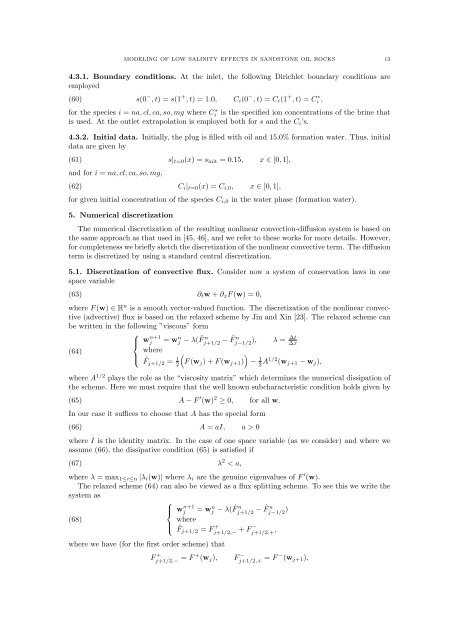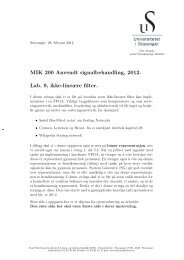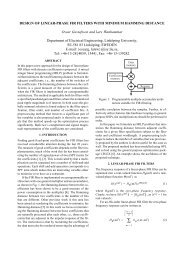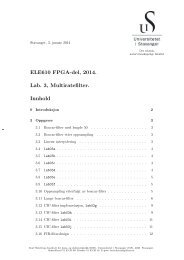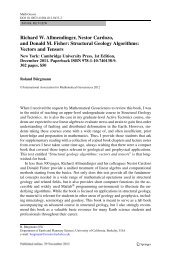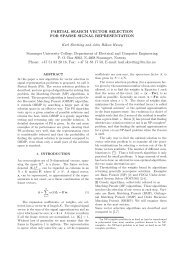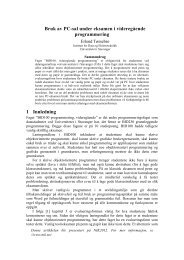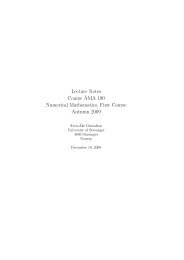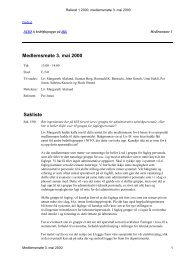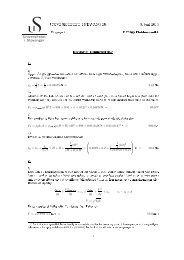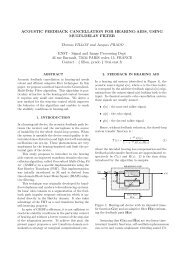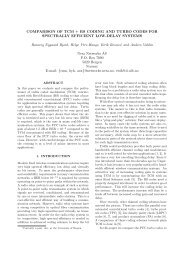MODELING OF LOW SALINITY EFFECTS IN SANDSTONE OIL ...
MODELING OF LOW SALINITY EFFECTS IN SANDSTONE OIL ...
MODELING OF LOW SALINITY EFFECTS IN SANDSTONE OIL ...
You also want an ePaper? Increase the reach of your titles
YUMPU automatically turns print PDFs into web optimized ePapers that Google loves.
<strong>MODEL<strong>IN</strong>G</strong> <strong>OF</strong> <strong>LOW</strong> <strong>SAL<strong>IN</strong>ITY</strong> <strong>EFFECTS</strong> <strong>IN</strong> <strong>SANDSTONE</strong> <strong>OIL</strong> ROCKS 134.3.1. Boundary conditions. At the inlet, the following Dirichlet boundary conditions areemployed(60) s(0 − , t) = s(1 + , t) = 1.0, C i (0 − , t) = C i (1 + , t) = C ∗ i ,for the species i = na, cl, ca, so, mg where Ci∗ is the specified ion concentrations of the brine thatis used. At the outlet extrapolation is employed both for s and the C i ’s.4.3.2. Initial data. Initially, the plug is filled with oil and 15.0% formation water. Thus, initialdata are given by(61) s| t=0 (x) = s init = 0.15, x ∈ [0, 1],and for i = na, cl, ca, so, mg,(62) C i | t=0 (x) = C i,0 , x ∈ [0, 1],for given initial concentration of the species C i,0 in the water phase (formation water).5. Numerical discretizationThe numerical discretization of the resulting nonlinear convection-diffusion system is based onthe same approach as that used in [45, 46], and we refer to these works for more details. However,for completeness we briefly sketch the discretization of the nonlinear convective term. The diffusionterm is discretized by using a standard central discretization.5.1. Discretization of convective flux. Consider now a system of conservation laws in onespace variable(63)∂ t w + ∂ x F (w) = 0,where F (w) ∈ R n is a smooth vector-valued function. The discretization of the nonlinear convective(advective) flux is based on the relaxed scheme by Jin and Xin [23]. The relaxed scheme canbe written in the following ”viscous” form(64)⎧⎪⎨⎪⎩w n+1j = w n j − λ( ˆF n j+1/2 − ˆF n j−1/2), λ =∆t∆xwhere()ˆF j+1/2 = 1 2F (w j ) + F (w j+1 ) − 1 2 A1/2 (w j+1 − w j ),where A 1/2 plays the role as the “viscosity matrix” which determines the numerical dissipation ofthe scheme. Here we must require that the well known subcharacteristic condition holds given by(65)A − F ′ (w) 2 ≥ 0, for all w.In our case it suffices to choose that A has the special form(66)A = aI, a > 0where I is the identity matrix. In the case of one space variable (as we consider) and where weassume (66), the dissipative condition (65) is satisfied if(67)λ 2 < a,where λ = max 1≤i≤n |λ i (w)| where λ i are the genuine eigenvalues of F ′ (w).The relaxed scheme (64) can also be viewed as a flux splitting scheme. To see this we write thesystem as(68)⎧⎪⎨where we have (for the first order scheme) that⎪⎩w n+1j = w n j − λ( ˆF n j+1/2 − ˆF n j−1/2 )whereˆF j+1/2 = F + j+1/2,− + F − j+1/2,+ ,F + j+1/2,− = F + (w j ), F − j+1/2,+ = F − (w j+1 ),


